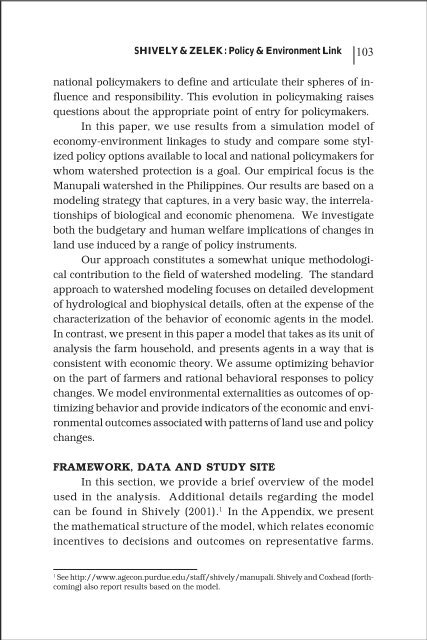Linking Economic Policy and Environmental Outcomes at a ...
Linking Economic Policy and Environmental Outcomes at a ...
Linking Economic Policy and Environmental Outcomes at a ...
- No tags were found...
You also want an ePaper? Increase the reach of your titles
YUMPU automatically turns print PDFs into web optimized ePapers that Google loves.
SHIVELY & ZELEK : <strong>Policy</strong> & Environment Link 103n<strong>at</strong>ional policymakers to define <strong>and</strong> articul<strong>at</strong>e their spheres of influence<strong>and</strong> responsibility. This evolution in policymaking raisesquestions about the appropri<strong>at</strong>e point of entry for policymakers.In this paper, we use results from a simul<strong>at</strong>ion model ofeconomy-environment linkages to study <strong>and</strong> compare some stylizedpolicy options available to local <strong>and</strong> n<strong>at</strong>ional policymakers forwhom w<strong>at</strong>ershed protection is a goal. Our empirical focus is theManupali w<strong>at</strong>ershed in the Philippines. Our results are based on amodeling str<strong>at</strong>egy th<strong>at</strong> captures, in a very basic way, the interrel<strong>at</strong>ionshipsof biological <strong>and</strong> economic phenomena. We investig<strong>at</strong>eboth the budgetary <strong>and</strong> human welfare implic<strong>at</strong>ions of changes inl<strong>and</strong> use induced by a range of policy instruments.Our approach constitutes a somewh<strong>at</strong> unique methodologicalcontribution to the field of w<strong>at</strong>ershed modeling. The st<strong>and</strong>ardapproach to w<strong>at</strong>ershed modeling focuses on detailed developmentof hydrological <strong>and</strong> biophysical details, often <strong>at</strong> the expense of thecharacteriz<strong>at</strong>ion of the behavior of economic agents in the model.In contrast, we present in this paper a model th<strong>at</strong> takes as its unit ofanalysis the farm household, <strong>and</strong> presents agents in a way th<strong>at</strong> isconsistent with economic theory. We assume optimizing behavioron the part of farmers <strong>and</strong> r<strong>at</strong>ional behavioral responses to policychanges. We model environmental externalities as outcomes of optimizingbehavior <strong>and</strong> provide indic<strong>at</strong>ors of the economic <strong>and</strong> environmentaloutcomes associ<strong>at</strong>ed with p<strong>at</strong>terns of l<strong>and</strong> use <strong>and</strong> policychanges.FRAMEWORK, DATA AND STUDY SITEIn this section, we provide a brief overview of the modelused in the analysis. Additional details regarding the modelcan be found in Shively (2001). 1 In the Appendix, we presentthe m<strong>at</strong>hem<strong>at</strong>ical structure of the model, which rel<strong>at</strong>es economicincentives to decisions <strong>and</strong> outcomes on represent<strong>at</strong>ive farms.1See http://www.agecon.purdue.edu/staff/shively/manupali. Shively <strong>and</strong> Coxhead (forthcoming)also report results based on the model.










